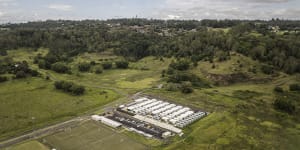Byron Shire Council has flagged its three pod villages,set up around Brunswick Heads and Mullumbimby,as possible locations for permanent development in its new housing options paper,

The pod villages are providing homes for more than 1000 flood victims in the Northern Rivers.Brook Mitchell
The region is facing significant housing pressure on the back of COVID-19 migration and last year’s record-breaking floods,which left thousands of people homeless.
The median house price in Byron Shire almost doubled between 2020 and 2022,before falling to $1.42 million earlier this year. Rental stress is also high and the vacancy rate is below 1 per cent.
Last month, on short-term holiday rentals in most of the shire to improve the housing shortage,but told the council it still had to find 4500 homes by 2041.
But residents fear the development push in Byron,through proposed new land release and higher density in existing areas, and rob the community of much-needed green space.

Ballina Greens MP Tamara Smith said such development had to be the subject of nuanced conversation and she questioned where the infrastructure was to support the housing push,most of which is focused on Mullumbimby and Brunswick Heads.
“Our community is very engaged,” she said. “I don’t think it’s NIMBYism. They want to see ecologically sustainable development. We have lived through natural disasters,we know where[climate change] gets us. And we don’t want to squander the rich biodiversity we already have.”
Amid the housing shortage after the floods,the NSW Reconstruction Authority used emergency exemptions to planning laws to build 11 pod villages across the Northern Rivers,largely on public land,which could shelter flood victims until they found a new home or rebuilt.
The villages now accommodate more than 1000 people,who live in modular “pod” units that have been connected to plumbing and electricity.
The villages were meant to operate for two years,but a spokesperson for the NSW Reconstruction Authority told theHerald that under the legislation,they can be used for up to five years.
When asked if the villages themselves or the sites on which they were built could be used to address the broader housing crisis,the spokesperson said the authority was “committed to working with the NSW government,community and council to determine the future of each temporary housing village”.
Smith said some pod sites in her electorate,like one in Ballina,could be suitable for proper permanent housing,but other sites should be returned to the community.
“The pod village in Mullumbimby 100 per cent should not stay there,” she said. That village has been built in the old railway corridor on land owned by the Transport Asset Holding Entity.

Peter Tanner,Bayside Residents Association president,fears emergency accommodation on public parkland will become permanent housing at Brunswick Heads once flood victims no longer need it.Danielle Smith
“It is a flood zone. There is real concern about the impact of that much landfill on other houses.”
Another village at Bayside,near Brunswick Heads,which is built on council and privately owned land,“has taken up a large section of the community park”,which Smith said should be upgraded and returned to the community once the pod village is no longer needed for flood victims.
Bayside Residents Association president Peter Tanner said the park was the only green space in a suburb that is about to double in size.
A new 123-house subdivision has been approved in Bayside,despite ongoing opposition over the loss of frog and bird habitat. Construction is due to start soon.
“We support the people in the pods. It was a genuine emergency,people were traumatised and distressed and we want to welcome them in,” Tanner said. “Our issue is whether council will make good the land,and we have some doubts about that.
“There is nowhere in our area for kids to play,or kick a ball around. A lot of young people live around here and they’ve got nowhere to go.”
Byron Shire Mayor Michael Lyon said the council was yet to determine the future of the Bayside pod site,but he believed it was not a long-term housing solution.
“For open spaces like[Bayside],for a temporary thing,I don’t think we can continue to have that as a permanent imposition on the community,” he said.
“Around the other two pod sites … we are definitely keen for them to continue as transitional housing until such time as the housing crisis is alleviated.”
When asked about the Tweed’s two pod villages,Tweed Shire Council said its preference was that the state government find long-term housing solutions for flood victims.
Ballina Shire Council,which has three pod villages and owns the land for one of them,said it was working on a strategy to enhance housing security in the area and encourage greater housing diversity,and the strategy would likely be approved next year.
Start the day with a summary of the day’s most important and interesting stories,analysis and insights..